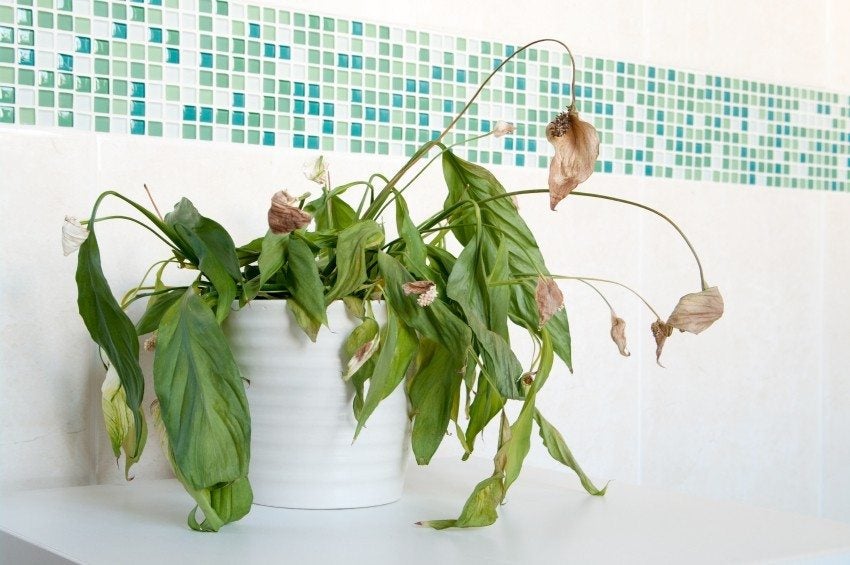Desperate Houseplants: Dealing With Common Houseplant Diseases


Houseplants can develop many problems, mostly due to environmental or cultural causes. Diseases aren't that common on most houseplants grown indoors because environmental conditions aren't favorable for plant pathogens to grow and infect the plants. However, there are fungal, viral, and bacterial conditions that can affect them. Read on to learn more.
Preventing Houseplant Problems
The first step in controlling most diseases is prevention. Always buy disease-free plants. Use clean soil when repotting, carefully scrubbing pots before reusing to kill any disease organisms that may be present. Providing your houseplants with the proper growing conditions, giving them plenty of TLC and checking them often for problems will significantly reduce the chances of disease, turning desperate houseplants into happy ones. Watering may be the most important aspect of healthy plants, however, most people tend to overwater, creating breeding grounds for fungi and other disease-causing agents. Always check the soil first to determine if watering is necessary by sticking your finger in the soil. If it's dry, add some water, but if it's wet (or slightly moist), leave it alone. Also, make sure all houseplants have adequate ventilation, which includes plenty of room. In other words, don't crowd them. Continually check for and remove spent flowers and foliage as well.
Dealing with Common Houseplant Diseases
Fungal Diseases
Fungi are one of the most common factors of disease in houseplants. Most of these can be contributed to overwatering, as most fungi need moisture to thrive. Here are the most common fungal problems you may encounter with your indoor plants:
- Anthracnose - Anthracnose presents itself with leaf tips that become yellow, gradually turning dark brown and eventually dying. Infected leaves should be picked off and destroyed.
- Root and stem rot - Both root rot and stem rot can be associated with fungus, due mostly to overly wet soil from poor drainage or overwatering. Both the roots and stem become soft, turn brown/black, wilt and die. Generally, it's too late to save the plant once you notice this disease, however, this can easily be prevented with the correct use of watering and good drainage. If only some of the roots are affected, however, repotting the plant in a sterilized pot may help.
- Leaf spots - Fungal leaf spots may include small brown spots with yellow margins or black spotting. Remove and destroy the affected houseplant as the fungi thrive on decaying plant matter. Neem oil can also help.
- Botrytis - Botrytis, or gray mold, is another disease brought on by fungi. This appears as fuzzy, gray mold on the foliage and stems. Since it spreads easily, it's best to discard the entire plant and sterilize the pot. To prevent botrytis, inspect houseplants daily for brown or dead leaves and promptly remove them.
- Powdery mildew - Powdery mildew leaves a white powder-like coating on all parts of the plant. These infections are generally the result of fungi either from decaying plant matter or from airborne spores and high humidity. Good ventilation and careful watering is recommended. Allow the plant to dry out, placing in a sunny location, if necessary. For severely infected plants, remove and destroy.
Viral or Bacterial Diseases
Some houseplants develop viral or bacterial diseases. Those affected by a virus are not as common unless left outdoors, although, they may appear stunted in growth with crinkled leaves and mottled color. More often than not, viral infections are caused by insects, such as aphids and nematodes. Houseplants affected by bacterial dropsy or edema exhibit water-soaked spots with cork-like swellings along the leaf surface and stem. Houseplants may not fully recover, but, repotting can help improve their chances, as well as drainage and ventilation. Otherwise, they should be removed and destroyed.
Sign up for the Gardening Know How newsletter today and receive a free copy of our e-book "How to Grow Delicious Tomatoes".

Nikki Tilley has been gardening for nearly three decades. The former Senior Editor and Archivist of Gardening Know How, Nikki has also authored six gardening books.